What to Know Before Trekking in the Himalayas
- Ghumo Phiro Travel

- Jun 9
- 3 min read
Trekking in the Himalayas is a dream for many adventure lovers. Among the many stunning treks that this majestic range offers, the Kedarkantha trek stands out for its natural beauty, cultural significance, and thrilling experience. However, before you lace up your hiking boots and set off, there are some essential things you should know to ensure a safe and enjoyable journey.
Kedarkantha Trek: An Overview
The Kedarkantha trek is located in the Govind Wildlife Sanctuary, in Uttarkashi, Uttarakhand, India. This trek offers breathtaking views, a variety of terrains, and the chance to witness diverse flora and fauna. Spanning approximately 20 kilometers, the trek usually takes about 5-6 days to complete, making it accessible for both beginners and experienced trekkers.

The best time to trek Kedarkantha is from December to April when the snow blankets the landscape. The picturesque views of snow-covered peaks, frozen lakes, and crystal-clear skies make for an unforgettable experience. The trek presents an array of challenges, from steep ascents to slippery descents, but the reward at the summit is worth every step taken.
Preparation is Key
Proper preparation is crucial for a successful trekking experience. Before setting off on your adventure, make sure to do the following:
Physical Fitness: Trekking often involves long days of walking on rugged paths. Engaging in regular cardiovascular workouts, strength training, and flexibility exercises can prepare your body for the physical demands of the trek.
Gear and Equipment: Invest in quality trekking gear. A sturdy pair of hiking boots, comfortable clothing, a warm jacket, and reliable trekking poles can make a significant difference. Additionally, don’t forget to carry a good quality backpack, hydration system, and first aid kit.
Research the Trek Route: Familiarize yourself with the trail, campsites, and available facilities along the route. Knowing terrain details and weather conditions can help you plan better and avoid unexpected obstacles.

Permits and Regulations: Ensure you have all the necessary permits to trek in the area. Research the regulations in advance and ensure you comply to avoid last-minute hassles at checkpoints.
Trekking Safety Tips
Safety should always be your top priority while trekking in the Himalayas. Here are some tips to keep in mind:
Acclimatization: To prevent altitude sickness, take time to acclimate, especially if you're trekking at higher elevations. Spend at least one day at lower altitudes before ascending further.
Travel with a Guide: While it is possible to trek independently, it's advisable to consult with a local trekking agency or hire a guide who can provide invaluable insights and assistance.
Stay Hydrated: Always carry sufficient water and drink regularly, even if you don't feel thirsty. At higher altitudes, you may not feel thirsty but your body still requires hydration.
Emergency Contacts: Keep a list of emergency contacts, including local authorities, your trekking agency, and family or friends. Ensure your phone is charged and carry a power bank if possible.
Local Culture and Etiquette
When trekking in the Himalayas, you will inevitably interact with local communities. Respect and cultural sensitivity are crucial. Here are some points to keep in mind:
Dress Modestly: While trekking, dressing appropriately is essential, especially in rural areas. Opt for clothing that is comfortable and respectful of local customs.
Learn Basic Hindi Phrases: Though many locals understand English, knowing a few basic phrases in Hindi can help you connect with them and show respect for their culture.
Support the Local Economy: Consider buying souvenirs or local handicrafts from the villages you pass through. This supports the community and enhances your trekking experience.
Leave No Trace: Preserve the beauty of the Himalayas by following the Leave No Trace principles. Carry your trash, minimize campfire impact, and avoid disturbing wildlife.

Essential Gear List for the Kedarkantha Trek
Here’s a quick checklist of essential gear to pack for your Kedarkantha trek:
Clothing: Moisture-wicking base layers, thermal layers, waterproof jacket, trekking pants, warm gloves, and a sturdy hat.
Footwear: Waterproof hiking boots, thick woolen socks, and camp shoes.
Safety Items: First aid kit, headlamp, multi-tool, and emergency whistle.
Camping Gear: Tent, sleeping bag, sleeping mat, and cooking equipment if you're camping independently.
Personal Items: Sunscreen, sunglasses, toiletries, and any personal medication.
Final Thoughts on the Kedarkantha Trek
In summary, the Kedarkantha trek offers an incredible opportunity to experience the beauty of the Himalayas, develop your trekking skills, and engage with rich local culture. Being prepared, staying safe, and respecting the environment and local communities will enhance your experience.
For those considering the adventure, there are various kedarkantha trekking package options that cater to different needs and preferences. Whether you're seeking a guided group experience or a self-guided adventure, the options available will ensure your journey is memorable.
By following these tips and preparing adequately, you’re well on your way to enjoying one of the most magnificent treks in the world. Happy trekking!




Comments